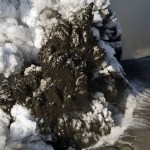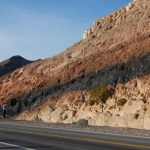Science Journalism
Africa is threatened by "scorching hot blobs of magma" according to the CSM.
Nothing like some fabulous headlines to make your day.
The first (courtesy of the Christian Science Monitor)
Massive blob of scorching magma discovered under southern Africa
Oh my! Yes, again, it seems that the many people in the media seem to be very confused about the nature of magma when it is underground - always expecting giant vats of swirling, molten magma rising up to destroy us all. Very few have a good sense of the real state of the Earth's mantle - mostly solid. The article is in fact about a recent study…
Looking for some volcano news - you've found it.
A shot of volcano "tourists" near the erupting Pacaya. Photo by the Associated Press.
Eruptions reader Dr. Boris Behncke dropped a note that Kilauea has not one but two active lava lakes right now. The lava lakes can be seen on the webcams for the Halema`uma`u Crater and the Pu`u O`o flank vent. The latest status update from June 6th by the USGS Hawaiian Volcano Observatory talks about both the summit and rift activity (video) on Kilauea as well. Meanwhile, Hawaii 24/7 has a piece in the Volcano Watch series about whether residents of Maui…
In reverse order:
5. Â David Sloan Wilson, pissing off the angry atheists.
"I piss off atheists more than any other category, and I am an atheist." This sparked some lively action in the comments.
4. Lively or not, Wilson and Dawkins lost fourth place to snail jokes.
A turtle gets mugged by a gang of snails. 
3. A walking tour that lets you See exactly where Phineas Gage lost his mind
Â
2. "Push" science journalism, or how diversity matters more than size
We're constantly told -- we writers are, anyway -- that people won't read long stories. They're…
This week has been destroyed by workshops and my last death throes with a paper I am submitting on my research in New Zealand. And to think, I thought it might settle down a little after the students left.
To news!
Ash fall on a taxi cab near Guatemala's Pacaya.
Pacaya in Guatemala erupted yesterday causing evacuations of people near the volcano and the closure of Guatemala City's main airport. Pacaya is a mere ~25 km from the capitol of this Central American nation. Tragically, a news reporter from one of the capitol's TV stations died when they were struck by volcanic debris, again…
Tomorrow morning at the Howard Hughes Medical Institute, I will be addressing the annual conference of the University Research Magazine Association. I have pasted the text of my prepared remarks below with relevant links embedded. I will post a follow up on Friday highlighting questions, comments, and reactions. Readers are strongly encouraged to weigh in with their own reactions.
As professional science communicators and journalists, you are living in an era of convergence between two major trends in society.
The first trend is a dominant focus of this conference: Technology, audience…
News, news, news!
Ash from Eyjafjallajökull piling up on a roof at Seljavellir. Image courtesy of the IMO, by Ari Tryggvason.
The latest from Eyjafjallajökull has the volcano continuing to puff away - producing intermittent airspace closures over Europe. The Icelandic Met Office reports a ~7 km (21,000 foot) ash plume, but they note that the explosivity of the eruption seems to have waned some since a maximum on May 13. Right now, the IMO estimates the eruption rate at ~200 tonnes/second. Lets put that in a little perspective - a Ford F-150 pickup weighs about 2 tonnes, so the volcano is…
Next week the Howard Hughes Medical Institute will be hosting the annual conference of the University Research Magazine Association (URMA). The association is comprised of editors and staffers at magazines that cover the research and scholarly activities of universities, nonprofit research centers, and institutes in the U.S., U.K., Canada, and Europe.
Depending on your field and professional background, you may or may not be familiar with publications such as Yale Medicine, UNC's Endeavors, the HHMI Bulletin, Florida State's Research in Review, and Arizona State's Research Stories and…
I've been deemed a pusher, and that's a good thing.
The accuser is Colin Schultz, a busy, curious, and inquisitive young journalist who awarded a story of mine his first annual prize for "push" science journalism. First of all let me say I'm pleased, mainly because the story, " A Depression Switch?", about neurologist Helen Mayberg's experiment using deep brain stimulation to treat depression, is one of the most fascinating, enthralling, and rewarding I've ever worked on.
But what is this push journalism business? Push science journalism, says Colin, is…
There's a minor kerfuffle at the moment over the XENON experiment's early data (arxiv paper) which did not detect any dark matter in 11 days of data acquisition. This conflicts with earlier claims by the DAMA experiment and recent maybe-kinda-sorta detections by the CoGeNT and CDMA experiments.
As a result, a couple of members of other collaborations have posted a response on the arxiv saying, basically, that they don't believe the sensitivity claimed for the XENON detector in the energy range in question, and that their result can't really be said to rule out the possibility of dark matter…
Mt. Saint Helens erupting in 2004.
I had a chance to watch a new NOVA special that airs May 5 (PBS) on the 1980-1986 and 2004-2008 eruption cycles at Mt. Saint Helens, along with the recovery of the blast zone from the 1980 eruption. It is a fitting episode as we approach the 30th anniversary of the eruption that took out the north side of the volcano and devastated a vast swath of Cascade wilderness in Washington on May 18, 1980. Many of you have already sent me your Mt. Saint Helens memories (keep them coming!) for my tribute to the eruption, but if you want to get started on remembering…
I got the chance to attend a panel discussion about science and the media presented by the UK-based charity Sense About Science. The audience was primarily scientists, many of whom were angry about how science is presented in the media: the outlandish claims, the hype, presenting "both sides" of stories where there is clear scientific consensus. The panel included a professional scientist who teaches about communicating with the public, an editor at the journal Cell, and a science reporter for the Boston Globe.
The panel was mostly about "traditional" media, with a little shout-out to blogs…
A Federal inter-agency report released today reviews eleven key categories of diseases and other health consequences that are occurring or will occur due to climate change. The report, A Human Health Perspective on Climate Change, provides a starting point for coordination of federal research to better understand climate's impact on human health. The recommendations of the working group include research to identify who will be most vulnerable, and what efforts will be most beneficial.
Not only does this report call attention to objectively serious risks of climate change, but on Earth Day,…
Eyjafjallajokull erupting on 4/17/2010, image by Marco Fulle. Note the "rooster tails" of ash and steam, typical for Surtseyan eruptions.
European airspace has slowly begun to reopen as the explosive eruptions at Eyjafjallajökull have become less intense over the last 24 hours. However, there is still lots of hazardous airspace and airports around places like London and across the UK remain closed - leaving people stranded. We will still have to wait to see what the political ramification are, especially after EU officials claim "flaws" in their decision and the over $1 billion losses by…
Organizers of the upcoming Science for Media Forum in Madrid, Spain have launched a blog as part of the build up to the event. In the first posts, several European-based journalists raise concerns about the increased financial pressures on news organizations that have reduced the amount and quality of science coverage. At the same time, there is concern about the resources spent on journalism in comparison to those spent on public relations, including the contributions to "science hype" from university-based communication initiatives.
In articles published with colleagues last year and in…
Lots to do!
Tourists flock to the Eyjafjallajökull-Fimmvörduháls in Iceland.
The media does love the term "supervolcano", and a number of Eruptions readers sent me a link to the article on the dreaded submarine "supervolcanoes". I would delve into this article from Live Science, but it sadly again does a dreadful job with a lot of this - remember, "supervolcano" is a made-up word by the BBC with no strict definition, so trying to say there are a dozen supervolcanoes worldwide is just silly. And why does it take multiple paragraphs and multiple mentions of "scientists" before they get a…
Today's breaking news in Ant Science is this:
Newly discovered pieces of amber have given scientists a peek into the Africa of 95 million years ago, when flowering plants blossomed across Earth and the animal world scrambled to adapt.
Suspended in the stream of time were ancestors of modern spiders, wasps and ferns, but the prize is a wingless ant that challenges current notions about the origins of that globe-spanning insect family...Inside the Ethiopian amber is an ant that looks nothing like ants found in Cretaceous amber from France and Burma.
Wow- that's big news! I wonder what this…
This year the School of Communication at American University has hired leading junior faculty in the areas of science journalism and risk communication. The two new faculty, scheduled to move to Washington, DC in August, will contribute significantly to SOC's research capacity, professional initiatives, and teaching portfolio. Below with their permission, I have posted brief bios.
DECLAN FAHY
Declan Fahy joins the journalism faculty as a tenure-track assistant professor. He has reported extensively on science, health, and environmental issues, as well as many other topics, for the Irish…
Map showing the location of submarine volcano Marsili, near the Italian coast. Image from INGV.
The subject of submarine volcanism near Italy has come up before here on Eruptions but now it has made the jump into the worldwide media after some claims made by Enzo Boschi, president of the National Institute of Geophysics and Volcanology (INGV).
The long and short of what I can tell from the articles is that Marsili, a submarine volcano in the Tyrrhenian Sea, could be a threat to create a significant tsunami that would hit Italy (amongst other Mediterranean countries). The volcano lies only…
Alan Boyle, Science Editor for MSNBC.com, was kind enough to answer questions about science in the mainstream media after the fallout of the coverage of the Chilean earthquake.
Alan Boyle, science editor for MSNBC.com
Alan has been with MSNBC.com since 1996, covering science and technology. He has his own blog on space called the Cosmic Log. He's also won quite the array of awards including from the National Academies, the American Association for the Advancement of Science, the National Association of Science Writers, the Society of Professional Journalists, the Space Frontier Foundation,…
I'm still playing catch-up after my week in the desert, so I've seen a lot of articles I've wanted to mention ... but a certain other volcano has taken up a lot of my time. However, I will attempt to make amends for that now.
By the way, would you believe Ubehebe Crater was closed? How do they close a volcano, anyway? However, I did get a great snap of a welded tuff on the road outside of Shoshone, CA.
A strongly welded tuff near Shoshone, CA. The dark interior is remelted volcanic ash/tephra surrounded by less welded pink tuff with abundant pumice clasts. Denison student David Sisak is on…

